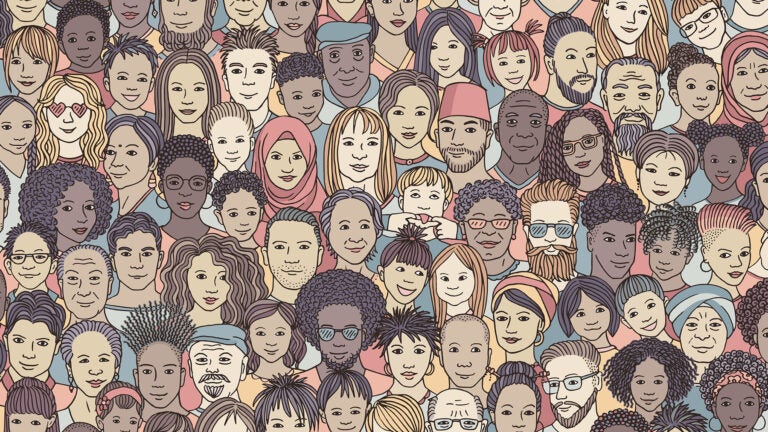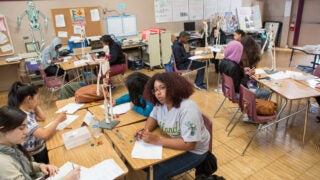
Racial and ethnic minority groups make up about 39% of the U.S. population, but these groups represent just 2% to 16% of patients in trials. (Illustration/AdobeStock)
USC health researchers rise to the challenge of improving diversity in clinical trials
Clinical trial diversity has two key ingredients: training and hiring a more diverse group of clinical professionals, and enrolling more racially and ethnically diverse participants.
When USC cancer epidemiologist Mariana Stern arrived in the United States to pursue a science career, her PhD mentor was from Argentina, just as she was. He understood her culture, where she came from, what her training was like — and helped her feel confident and at home. Today, when she goes to a conference and meets trainees from Latin America, she immediately connects, gives them her business card and tells them to reach out to her.
Stern follows that same approach in her efforts to diversify research at USC. By cultivating personal connections among budding scientists and potential clinical trial participants alike, she helps make the medical research enterprise feels like a place where they belong.
“When you come to a new country, there’s so much that you have to learn,” says Stern, associate director for population sciences at the USC Norris Comprehensive Cancer Center and professor of population and public health sciences and urology at the Keck School of Medicine of USC. “It’s not just the training, right? It’s the culture, the lifestyle. Having somebody who understands that is a game-changer.”
When you come to a new country, there’s so much that you have to learn.
Mariana Stern, USC cancer epidemiologist
There are really two challenges with clinical trial diversity. Training and hiring a more diverse group of clinical professionals is one. Enrolling more racially and ethnically diverse participants is the other. Differences in health risks and conditions mean treatments are not one-size-fits-all.
For example, Black men still have a higher risk of developing lung cancer compared with white men, even though they tend to smoke less — an effect referred to as the “Black smoking paradox.” Black patients are also more likely than white patients to be diagnosed at later stages and to receive no treatment at all for their cancer, according to Chanita Hughes-Halbert, associate director for cancer equity at USC Norris and a professor and vice chair of research in the Department of Population and Public Health Sciences at the Keck School.
Racial and ethnic minority groups make up about 39% of the U.S. population, but these groups represent just 2% to 16% of patients in trials, according to a recent report in the Harvard Business Review. The clinical trial workforce is similarly skewed, with Latino and Black employees occupying only 8% and 9% of jobs respectively in science, technology, engineering and math, according to the Pew Research Center.
Stern is one of many researchers across the university committed to tackling this problem.
Talk to the people you want to recruit and build your study around them
“We’ve learned from our community outreach and engagement officers, who do a terrific job of connecting with the patients through town halls, focus groups, meeting with them,” Stern says. “When you talk with the patients you want to recruit ahead of time, and hear their concerns, and ask what it will take for them to participate, you build that into your study.”
For example, a clinical trial may involve extra patient visits and procedures, requiring transportation and time off from work. If those questions aren’t addressed through incentives like gift cards and reimbursement for Lyft rides, the prospective patient may decide participation costs too much and will not enroll in the study.
It rankles Stern when people cite mistrust of the medical establishment, or abuses such as the Tuskegee syphilis study, as reasons why clinical trials aren’t more diverse. To her ear, that is letting scientists off too easy.
“There’s a little bit of mistrust, for sure,” she said. “But it’s also the fact that Hispanic patients who don’t speak English are often being approached in English — so of course, they’re not going to participate. When you present things in a way that is culturally appropriate, with proper language translated, with a patient navigator who can walk them through the process, they participate just fine. It’s not a problem.”
Many of these strategies and success stories can be traced to USC’s Lourdes Baezconde-Garbanati, the associate dean for community initiatives at the Keck School of Medicine, the associate director for community engagement at USC Norris and the director of the Center for Health Equity in the Americas. Earlier in the COVID-19 pandemic, she tested another communication form they had used previously in cancer education: three short films to increase COVID-19 vaccination in Black and Latino residents in L.A.
Facts inform — but stories transform.
Lourdes Baezconde-Garbanati, Keck School of Medicine of USC
“Facts inform — but stories transform,” said Baezconde-Garbanati.
A multidisciplinary team from Vaccinate L.A. assembled separate film crews made up of Latino and Black graduate students from the USC School of Cinematic Arts and the USC Annenberg School for Communication and Journalism. Together, they made three short films to counter vaccine hesitancy in Black and Latino communities. The crews wrote scripts countering the most prevalent COVID-19 myths, then went into production on real locations in Los Angeles.
Online surveys completed by a test audience showed an increase in the intent to get vaccinated, as well as rejection of commons myths surrounding the vaccines.
Find the person everyone trusts — and collaborate
Assal Habibi of the USC Dornsife College of Letters, Arts and Sciences wanted to recruit children from predominantly Latino schools for a study about musical training and childhood brain development. The research involved brain scans, which worried some parents, and involved travel to USC’s Brain and Creativity Institute lab, a turnoff for working parents.
Habibi’s lab coordinators, Priscilla Perez and Alison Wood, identified a woman at one of the schools who works as a “parent coordinator” — a liaison between families and the school — who helped the parents with paperwork and was someone families trusted.
The coordinator introduced the idea of the study to parents. Perez and Wood explained why the study was worth their time: Funding for music is often one of the first things to get cut; a study connecting musical training and brain development could help protect the program. They offered educational materials explaining the safety of brain scans, and part of the study’s funding paid for Lyft rides or parking.
“To build community-based research studies, it is important to include and involve community stakeholders in every step of research planning,” Habibi said. “Their input and involvement will not only add to the chances of success, but it helps researchers better understand their concerns and work together to address them. This results in building a trusting relationship for future studies as well.”
Train a diverse clinical trial workforce
“I think the most common misconception [about recruiting a diverse study population] is that it’s not possible, or that it’s hard. But it has not been given the priority it needs to be given,” says Rema Raman, a professor of neurology at the Keck School of Medicine of USC and director of biostatistics at USC’s Alzheimer’s Therapeutic Research Institute in San Diego. “Reaching individuals and groups that have never been part of the research system requires effort. It requires an investment of resources, of time, and it requires an understanding of the challenges that individuals are dealing with day to day.”
In 2020, Raman and her colleague Joshua Grill of the University of California, Irvine launched a program called IMPACT-AD to diversify the pool of people running clinical trials to test potential Alzheimer’s drugs. Their idea was that a diverse scientific workforce would attract a diverse patient population to studies.
Just three years later, the program has trained 90 professionals, and its alumni pages boast graduates from diverse backgrounds and career stages. A graduate of the program’s first year, Doris Molina Henry, has since joined the USC faculty. Prior to joining USC, Henry, a neurobiologist, was on the faculty of Winston-Salem State University, a teaching-intensive and minority-serving institution.
Diversity in research introduces a wealth of varied perspectives, lived experiences and cultural nuances to addressing major national and global problems.
Doris Molina Henry, USC neurobiologist
“Diversity in research introduces a wealth of varied perspectives, lived experiences and cultural nuances to addressing major national and global problems. It leads to a deeper, stronger science,” Henry said. “It infuses the science with alternative interpretations that can generate knowledge and solutions that are inclusive, and therefore can be generalized to populations for whom it wasn’t applicable before.”
Stern and her colleague John Carpten, chair of the Department of Translational Genomics, are working in a similar vein, cultivating young scientists at an early age. They co-direct a pipeline program called CARE2, a collaboration between the USC Norris Comprehensive Cancer Center, the University of Florida, and Florida A&M University, funded by the National Cancer Institute. The program provides research-training opportunities for underrepresented undergraduate and graduate students, postdoctoral fellows and early-stage investigators.
Use financial incentives to spur the drug industry into action
Economist Dana Goldman, dean of the USC Price School of Public Policy and co-director of the Schaeffer Center, views the issue through a financial filter.
If improved diversity in clinical trials reduced health disparities in heart disease, diabetes and hypertension by just 1%, that would result in more than $40 billion in gains for diabetes and $60 billion for heart disease, according to estimates from the Schaeffer Center’s Future Elderly Model. The Future Elderly Model is a tool to calculate the economic value of increased health and delayed aging.
“Following the money also leads to one of the best ways to turn the problem around,” Goldman said. “This means using financial incentives for individuals to participate in clinical trials and financial incentives for industry to develop clinical trials that have better representation.”
Developing effective and strategic incentives like tax credits, fast-track eligibility, exemptions from some FDA application fees, and extended market exclusivity for drugs would push industry players to act on this important issue, Goldman adds.
It’s worked before. Prior to the Orphan Drug Act of 1983, rare diseases were left out of the innovation pipeline because there wasn’t an economic incentive for pharmaceutical companies to invest resources for treatment and cures for diseases or conditions that afflict small numbers of people.
Since adoption of the policy, drugs brought to market as a result have helped millions of Americans.
The Schaeffer Center and the Alzheimer’s Therapeutic Research Institute at Keck School of Medicine recently received $5.8 million from Gates Ventures and the American Heart Association to launch a lab aimed at diversifying clinical trials. The program, which will target Alzheimer’s disease initially, will test ways to accelerate clinical trial development and increase participation from underserved groups in studies of new therapies and potential cures.
“The stagnant state of underrepresentation in clinical research is costing the U.S. too much and contributing to widespread health inequities,” Goldman said. “We can turn that around with incentives that spur the industry to action.”



